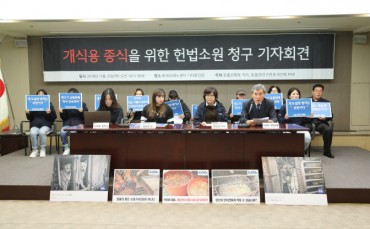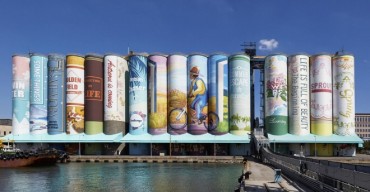
Questions are being raised as to why the marketing of alcohol is not receiving the same level of attention from regulators as tobacco products are. (Image: Yonhap)
SEOUL, Jan. 8 (Korea Bizwire) – Questions are being raised as to why the marketing of alcohol is not receiving the same level of attention from regulators as tobacco products are.
These viewpoints were expressed as a special committee formed by the Ministry of Health and Welfare held its first meeting last week at the Seoul Sejong Hotel to discuss the warning signs and images placed on cigarette packs.
The point of contention is that the government is taking a strong anti-smoking stance in regards to tobacco, but is otherwise hands-off when it comes to alcohol companies’ marketing activities, which frequently feature young, popular stars in glossily produced TV ads.
Not only are cigarette commercials banned from TV, but packs carry one of 10 different graphic images of laryngeal cancer, oral cancer, heart disease and other potential health problems associated with tobacco use. In contrast, bottles of alcohol are sold with only a written warning attached.
As such, experts have pointed out that cigarette packaging heavily emphasizes the downsides of smoking, while drinking advertisements omit all negatives and portray only a positive image of drinking.
The warning images found on cigarette packs in stores nationwide were first instituted in December 23, 2016 with a two-year deadline. On the same day this year, new images, warning labels or other changes that the Ministry of Health and Welfare’s special committee decides upon will replace the current packaging.
Belief in the efficacy of graphic images as a tool against smoking appears to be strongly held by the general public; a Korea Health Promotion Institute opinion survey found that respondents regarded the presence of the unsavory pictures to be more effective than a written warning along the lines of “smoking kills”. In addition, three out of four participants said that the graphic images should be enlarged.

These viewpoints were expressed as a special committee formed by the Ministry of Health and Welfare held its first meeting last week at the Seoul Sejong Hotel to discuss the health warning signs and images placed on cigarette packs. (Image: Yonhap)
The imbibing of liquor, on the other hand, is currently accessible without the pangs of unease that a picture of a cancer-ridden throat would in theory cause. Instead, bottles of spirits have warnings printed out discouraging pregnant women from partaking, as well as the general reminder that excessive drinking is a bad decision to make for one’s health.
In addition, laws governing or pertaining to alcohol only restrict advertising on radio or TV to certain times during the day, with internet marketing remaining completely untouched thus far.
On the cultural mindset regarding alcohol, one head of a NGO dedicated to keeping cigarettes and alcohol out of the hands of minors said, “The problem is that the alcohol commercials in our country give the viewer the feeling of wanting to have a glass. Casting celebrities that are the objects of teenagers’ adulation for these commercials and showing them indulging in alcohol can play a part in the problem of underage drinking.”
The question as to whether alcohol advertising needs to be addressed becomes more relevant when considering data that reveals smoking and drinking rates are going in opposite directions.
A Korean National Health and Nutrition Examination Survey found smoking among individuals 19 or older dropped from 28.8 percent in 2005 to 23.9 percent by 2016. Alcohol intake, specifically “dangerous drinking level” – seven glasses/shots or more in one sitting – rose in the same period from 11.6 percent to 13.8 percent. Furthermore, consuming alcohol at a dangerous drinking level once a month went from 36.2 percent to 39.3 percent.
The rise in drinking goes hand-in-hand with the results of a report from a research entity within the National Health Insurance Service, which revealed the social costs incurred by alcohol consumption in 2013 were 9.45 trillion won, far outstripping the 7.12 trillion won in damages caused by tobacco use.

“Casting celebrities that are the objects of teenagers’ adulation into these commercials and portraying them indulging in alcohol can play a part in raising underage drinking.” (Image: Hite Jinro)
Alcohol was also a major accomplice in a slew of crimes. Crime stats for 2016 provided by the National Police Agency show 39.2 percent of all murders, 28.9 percent of all sexual assault cases and 30.9 percent of all violent crimes were committed by perpetrators in a state of inebriation.
Taking this into account, it would seem regulations on alcohol are a matter of tantamount importance. However, a 2014 study published by the Korea Institute for Health and Social Affairs on the policies existing in OECD countries pertaining to alcohol gave South Korea a score of 7 points out of a possible maximum of 21, placing it 22nd out of the 30 countries examined.
One example where South Korea falls behind compared to its peers is that France, Iceland, Ireland, Sweden and others have banned outright advertisements of alcohol on TV and radio.
A researcher at the Korea Institute for Health and Social Affairs explained that the data indices for South Korea in the study could be interpreted to mean that weak regulations pertaining to alcohol coexist with high levels of alcohol consumption.
In response to these concerns, a Ministry of Health and Welfare official admitted that the need for regulation was keenly felt by the authorities. However, the spokesperson added that at this point in time, no detailed measures have been prepared to address the problem in earnest.
S.B.W. (sbw266@koreabizwire.com)







Pingback: After Crackdown on Tobacco Advertising, Will Al...